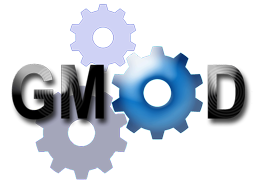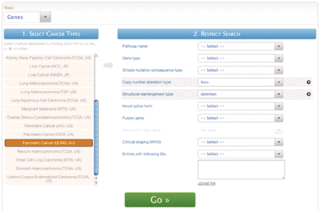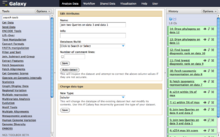
Bioinformatics is an interdisciplinary field of science that develops methods and software tools for understanding biological data, especially when the data sets are large and complex. Bioinformatics uses biology, chemistry, physics, computer science, computer programming, information engineering, mathematics and statistics to analyze and interpret biological data. The subsequent process of analyzing and interpreting data is referred to as computational biology.
In bioinformatics and biochemistry, the FASTA format is a text-based format for representing either nucleotide sequences or amino acid (protein) sequences, in which nucleotides or amino acids are represented using single-letter codes.

Metagenomics is the study of genetic material recovered directly from environmental or clinical samples by a method called sequencing. The broad field may also be referred to as environmental genomics, ecogenomics, community genomics or microbiomics.
Bioconductor is a free, open source and open development software project for the analysis and comprehension of genomic data generated by wet lab experiments in molecular biology.

The Generic Model Organism Database (GMOD) project provides biological research communities with a toolkit of open-source software components for visualizing, annotating, managing, and storing biological data. The GMOD project is funded by the United States National Institutes of Health, National Science Foundation and the USDA Agricultural Research Service.
GenePattern is a freely available computational biology open-source software package originally created and developed at the Broad Institute for the analysis of genomic data. Designed to enable researchers to develop, capture, and reproduce genomic analysis methodologies, GenePattern was first released in 2004. GenePattern is currently developed at the University of California, San Diego.

Apache Taverna was an open source software tool for designing and executing workflows, initially created by the myGrid project under the name Taverna Workbench, then a project under the Apache incubator. Taverna allowed users to integrate many different software components, including WSDL SOAP or REST Web services, such as those provided by the National Center for Biotechnology Information, the European Bioinformatics Institute, the DNA Databank of Japan (DDBJ), SoapLab, BioMOBY and EMBOSS. The set of available services was not finite and users could import new service descriptions into the Taverna Workbench.
Mark Bender Gerstein is an American scientist working in bioinformatics and Data Science. As of 2009, he is co-director of the Yale Computational Biology and Bioinformatics program.

In the fields of molecular biology and genetics, a pan-genome is the entire set of genes from all strains within a clade. More generally, it is the union of all the genomes of a clade. The pan-genome can be broken down into a "core pangenome" that contains genes present in all individuals, a "shell pangenome" that contains genes present in two or more strains, and a "cloud pangenome" that contains genes only found in a single strain. Some authors also refer to the cloud genome as "accessory genome" containing 'dispensable' genes present in a subset of the strains and strain-specific genes. Note that the use of the term 'dispensable' has been questioned, at least in plant genomes, as accessory genes play "an important role in genome evolution and in the complex interplay between the genome and the environment". The field of study of pangenomes is called pangenomics.

Robert Clifford Gentleman is a Canadian statistician and bioinformatician who is currently the founding executive director of the Center for Computational Biomedicine at Harvard Medical School. He was previously the vice president of computational biology at 23andMe. Gentleman is recognized, along with Ross Ihaka, as one of the originators of the R programming language and the Bioconductor project.
The Genomic HyperBrowser is a web-based system for statistical analysis of genomic annotation data.

BioMart is a community-driven project to provide a single point of access to distributed research data. The BioMart project contributes open source software and data services to the international scientific community. Although the BioMart software is primarily used by the biomedical research community, it is designed in such a way that any type of data can be incorporated into the BioMart framework. The BioMart project originated at the European Bioinformatics Institute as a data management solution for the Human Genome Project. Since then, BioMart has grown to become a multi-institute collaboration involving various database projects on five continents.
GenomeSpace is an environment for genomics software tools and applications. It helps users manage their analysis workflows involving multiple diverse tools, including web applications and desktop tools and facilitates the transfer of data between tools via automatic format conversion. Analyses can use data from local or cloud-based stores.
A bioinformatics workflow management system is a specialized form of workflow management system designed specifically to compose and execute a series of computational or data manipulation steps, or a workflow, that relate to bioinformatics.
MG-RAST is an open-source web application server that suggests automatic phylogenetic and functional analysis of metagenomes. It is also one of the biggest repositories for metagenomic data. The name is an abbreviation of Metagenomic Rapid Annotations using Subsystems Technology. The pipeline automatically produces functional assignments to the sequences that belong to the metagenome by performing sequence comparisons to databases in both nucleotide and amino-acid levels. The applications supply phylogenetic and functional assignments of the metagenome being analysed, as well as tools for comparing different metagenomes. It also provides a RESTful API for programmatic access.

Gene set enrichment analysis (GSEA) (also called functional enrichment analysis or pathway enrichment analysis) is a method to identify classes of genes or proteins that are over-represented in a large set of genes or proteins, and may have an association with different phenotypes (e.g. different organism growth patterns or diseases). The method uses statistical approaches to identify significantly enriched or depleted groups of genes. Transcriptomics technologies and proteomics results often identify thousands of genes, which are used for the analysis.
The BioCompute Object (BCO) project is a community-driven initiative to build a framework for standardizing and sharing computations and analyses generated from High-throughput sequencing. The project has since been standardized as IEEE 2791-2020, and the project files are maintained in an open source repository. The July 22nd, 2020 edition of the Federal Register announced that the FDA now supports the use of BioCompute in regulatory submissions, and the inclusion of the standard in the Data Standards Catalog for the submission of HTS data in NDAs, ANDAs, BLAs, and INDs to CBER, CDER, and CFSAN.
Originally started as a collaborative contract between the George Washington University and the Food and Drug Administration, the project has grown to include over 20 universities, biotechnology companies, public-private partnerships and pharmaceutical companies including Seven Bridges and Harvard Medical School. The BCO aims to ease the exchange of HTS workflows between various organizations, such as the FDA, pharmaceutical companies, contract research organizations, bioinformatic platform providers, and academic researchers. Due to the sensitive nature of regulatory filings, few direct references to material can be published. However, the project is currently funded to train FDA Reviewers and administrators to read and interpret BCOs, and currently has 4 publications either submitted or nearly submitted.
The 'German Network for Bioinformatics Infrastructure – de.NBI' is a national, academic and non-profit infrastructure initiated by the Federal Ministry of Education and Research funding 2015-2021. The network provides bioinformatics services to users in life sciences research and biomedicine in Germany and Europe. The partners organize training events, courses and summer schools on tools, standards and compute services provided by de.NBI to assist researchers to more effectively exploit their data. From 2022, the network will be integrated into Forschungszentrum Jülich.
Nextflow is a scientific workflow system predominantly used for bioinformatic data analyses. It imposes standards on how to programmatically author a sequence of dependent compute steps and enables their execution on various local and cloud resources. Nextflow was conceived at the Centre for Genomic Regulation in Barcelona, Spain, but has since found world-wide adoption in biomedical and genomics research facilities and laboratories.








